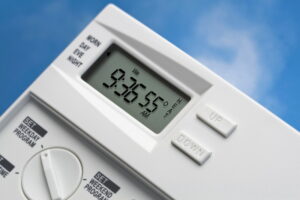 A piece of advice we often give to people who ask about ways they can save on their heating during the summer is to know how to set their thermostat from maximum efficiency. It’s best to keep a thermostat at a steady setting during the day, usually around 68°F, and then lower it by 8°F during the evening, or when people are away. This saves more energy than moving the thermostat up and down as you alternatively feel hot and then cold. This creates too much stopping and starting for the heating system, which wastes energy. The thermostat is a switch, not a throttle, so pushing it up higher doesn’t get you faster heating, only a heating system that runs longer.
A piece of advice we often give to people who ask about ways they can save on their heating during the summer is to know how to set their thermostat from maximum efficiency. It’s best to keep a thermostat at a steady setting during the day, usually around 68°F, and then lower it by 8°F during the evening, or when people are away. This saves more energy than moving the thermostat up and down as you alternatively feel hot and then cold. This creates too much stopping and starting for the heating system, which wastes energy. The thermostat is a switch, not a throttle, so pushing it up higher doesn’t get you faster heating, only a heating system that runs longer.
But what if you’re already setting the thermostat at a steady temperature, but one day find that you’re getting too hot or too cold, and you have to fiddle around with the thermostat regularly to get comfortable? This probably isn’t a “quirk.” It’s a warning that something isn’t going right somewhere in the HVAC system.
Could the thermostat be at fault?
Absolutely. This is the first part of the HVAC system our technicians will check when you call us to investigate why your comfort and the thermostat are at a disagreement. Modern thermostats are precise and intricate instruments that offer better comfort and energy savings, but with the downside that their programming could malfunction, leading to it running the heater at the wrong times. The thermostat could also have a failure with its temperature sensor, meaning it can’t detect the temperature in the house accurately, leading to you having to play around with it before it works right.
We can repair your thermostat, but we can also advise you on a thermostat upgrade if you have an older system or one that would be too expensive to repair.
Is the heating system broken?
Another possibility. The thermostat may be sending the right signals, but the heater is having problems meeting the temperature on the thermostat, or it’s overshooting it. There are numerous potential problems with a heater that can lead to this: a clogged air filter, problems with igniting the burners in a gas furnace or boiler, stress on the system causing it to cycle down too early, general loss of heating capacity due to age, faulty control board, etc. Please don’t try a diagnosis on your own to see what’s the matter—it takes professionals to find the source and fix it.
Any other possibilities?
Leaking air ducts could also result in problems with finding problem temperatures on the thermostat, especially if you have a zone control system. These ducts will force the heater to run longer to make up for the air lost, and you’ll find it hard to get the heating to match what you have on the thermostat. If some rooms are getting colder than others, duct leaks may be the trouble.
No matter what’s behind the fussy thermostat, our Mason, OH, HVAC experts can get to the bottom of it and see you have a comfortable home once more. We have 24-hour service available.
Call Bartels Heating & Cooling “For a Comfortable Way of Life.”
